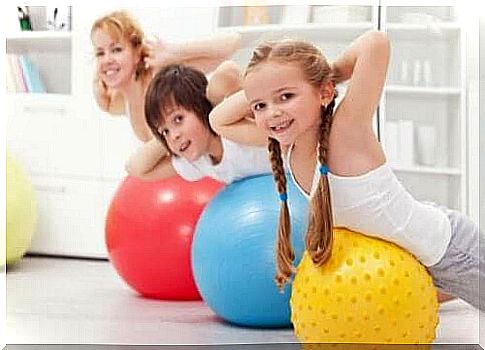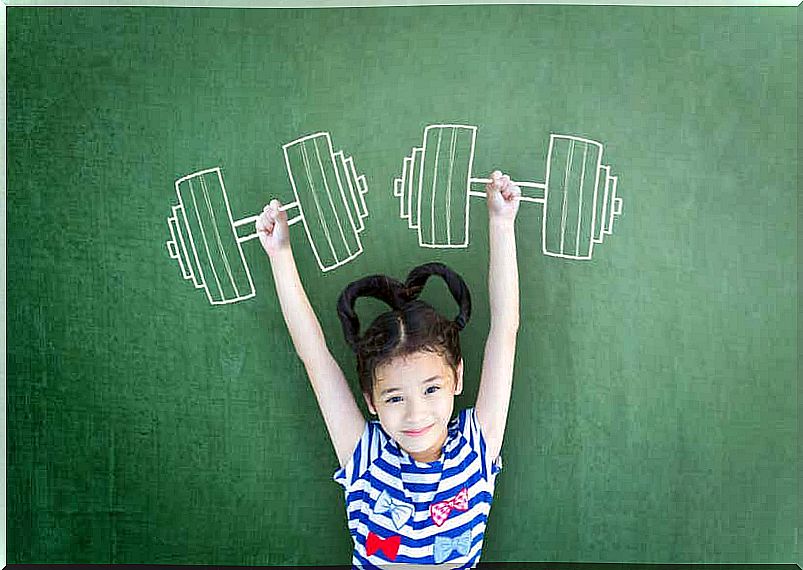Physical Training For Children: Everything You Need To Know

Physical exercise for children is any activity that aims to improve health, performance and quality of life. Unlike physical activity for adults, this exercise is planned, structured, and systematic. The age of the child does not matter. In fact, the sooner you start, the better. This is especially true when it comes to physical exercise for children.
Exercise keeps children away from a sedentary lifestyle and prevents obesity. In this regard, experts have raised some red flags in the last few years, especially as the use of communication technologies and social networks has increased, keeping even the youngest children in front of screens.
On average , children spend more than two hours on technological equipment a day, such as video games and cell phones. These affect the insufficient attention they give to physical exercise, and affect the high calorie intake.
The benefits of physical exercise for children

Physical exercise in children increases the metabolic activity of their muscles as they need more oxygen and nutrients while getting rid of waste products.
To achieve a metabolic increase, the system redistributes the blood flow to the active muscles. These absorb oxygen and nutrients.
Physical exercise for children improves the cardiovascular system, breathing, flexibility, strength, endurance and coordination. And that’s just the physical aspect, but there are social benefits as well. Exercise actually promotes the relationships they establish with others and with their surroundings, and improves on their personal level their self-esteem.
Consequences of the lack of physical exercise for children’s health
It is difficult to build the habit of physical activity and exercise in the light of the immobility and sedentary lifestyle that entertainment and communication technologies cause.
This reality has become even worse thanks to situations like the covid-19 pandemic. This has in many cases made outdoor life impossible as well as interrupted conventional life patterns.
Under these conditions, control of digital devices, fluid communication, and monitoring of routines, schedules, and basic habits are urgent needs.
In addition to the physical problems due to lack of exercise, such as obesity, diabetes, osteoporosis and disorders of the immune system, there are also intellectual and social problems. So inadequate physical activity has an impact on school performance, concentration and sleep.
If a healthy body reflects exercise, then the social aspects in turn reflect socialization. A child who exercises strengthens his bones and muscles while nurturing self-esteem and preventing depression, stress and discouragement.
Exercises that children can do
To improve the endurance, flexibility, muscle endurance and coordination of their cardiovascular system and breathing, we show some safe and simple alternatives for children.
The first is dance. Besides being good exerciser, it is a lot of fun. It involves the whole body, increases blood circulation, corrects posture and improves coordination. Similarly, there are certain yoga poses that you can perform with children at home.
You can also make races that children love to make, using strategies such as obstacles, distances and types of routes with a stopwatch in hand. Another exercise is to skip. It burns calories, improves coordination and concentration, trains and strengthens legs, arms, shoulders and spine and is an excellent aerobic workout.
As the latter, there are abdominal crunches and squats. With regard to the former, you should guide them with caution. Children use their parents as a role model, and abuse of abdominal crunches causes pain and atrophy. Planks, leg lifts and abdominal bends are strength exercises that require relative care.
Exercises that should not be performed by children

Some exercises endanger children’s muscles, tendons, joints and spine. Pay attention to them and try to avoid them. Although you may confuse them with play, they put pressure on sensitive and developing parts of children’s bodies.
Caution and common sense are the keys. For example, walking while squatting and holding on to your ankles can damage the meniscus, tendons and knees.
In terms of extent, bridges that involve bending backwards until your hands touch the floor are risky. This is because they put pressure on the spine.
Children should also avoid trying to touch their toes with their hands, which puts pressure on the spine, pelvis and abdominal muscles. The same goes for making quick circles with the head, which can affect the upper vertebrae of the neck. They should only perform them from side to side and carefully.
But exercises that children should never perform without adult and professional supervision are those that have to do with strength training with weightlifting. These are exercises that increase their bone mass, muscle strength and motor skills, but require special attention.
Myths about whether they affect growth have been dispelled. However, personal routines should preferably take place during a medical assessment.
WHO recommendations on physical activity for children
Sedentary lifestyle, obesity and inactivity cause nearly 5 million deaths in the world’s population every year. For this reason, the World Health Organization has warned of the need for children to spend less time sitting and more time playing.
The numbers speak for themselves: 23% of adults and 80% of young people “do not get enough physical exercise,” says the organization. Therefore, it is important to establish healthy lifestyle habits with fewer screens, more play and more hours of good quality sleep.
The recommendations aim to improve children’s motor and cognitive development in the first five years. This should form the basis of a healthy life. In all cases , no more than one hour of screen time and approximately three hours of physical activity should be allocated with routines and exercises of varying intensity, from moderate to high, during the day.
Physical exercise for children: A guarantee of health in adulthood
Research shows that cardiovascular disease occurs in childhood and adolescence. The high levels of lipids or fats, lipoproteins, blood pressure and obesity also reach adulthood.
In addition, exercise patterns in children tend to continue into adulthood. If children have not acquired certain habits before reaching adulthood, they are also unlikely to acquire them in adulthood. Overall, experts have concluded that childhood and adolescence are the foundation of healthy men and women.
At the same time, although physical condition and genetics weigh heavily in relation to physical activity, some elements are imperative. For this reason, it is crucial to create the social and motivating conditions and opportunities for children and young people to engage in physical exercise and competitive sports.









